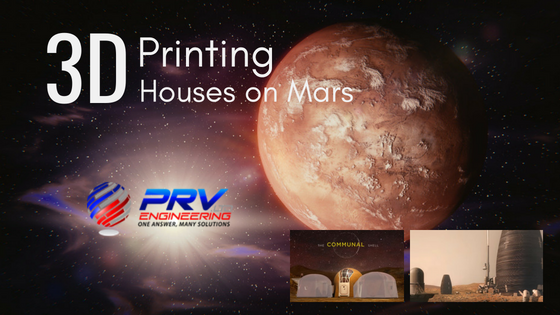
We see the benefits of 3D printing all the time from manufacturing, medical, the fashion industry to prototyping and production. With construction in mind and large-scale 3d printers, it is now possible to think about bigger projects. There’s no doubt that that additive manufacturing is an ideal building solution for creating models in architecture.
With that in mind, 3D printing has made headlines once again. This time though, it’s not a 3D printed house in your neighbourhood unless you live on Mars. We take a closer look at how the 3D printed habitat challenge from NASA and their partners have developed. If you are remotely interested in aerospace design, engineering and space exploration, you should really watch these videos.
Advanced 3D Printing Technologies With NASA
With great advances in deep space exploration, reliable and sustainable life-supporting habitats will be essential for successful colonisation. However, the challenge to build a structure on the surface of Mars remains incredibly difficult. This especially applies to our current limitations to transport building materials in addition to the differences in atmosphere and terrain.
NASA and their partners designed a $2.5 million competition to build a 3D printed habitat for deep space exploration. The primary focus of this endeavour is the space agency’s proposed journey to Mars. This challenge has multiple phases designed to advance our construction technology in order to create sustainable housing solutions. While the aim is housing for Mars, the approach will, needless to say, help 3D printing on Earth as well.
Pushing the envelope of design, technology and engineering, NASA’s Habitat Challenge encourages civilian inventors to be creative in their thinking. The idea is to develop sustainable shelters for the Moon, Mars and beyond focusing on 3D printing. An ideal solution includes technologies capable of using indigenous resources, recyclable or not, for additive manufacturing purposes. 3D printing structures using recyclable material already sounds a bit like science-fiction but then again, so does living on Mars.
The 3D Printing Habitat Challenge
The challenge began in 2014 and, as previously mentioned, is structured in three different phases:
- Phase 1 was the Design Competition. Here, teams were required to submit architectural renderings which ended in 2015 with total prize money of $50 000.
- Phase 2 was the Structural Member Competition. This phase focused on material technologies, requiring teams to create structural components. Phase 2 ended in 2017 with prize money totaling $1.1 million.
- Phase 3, the On-Site Habitat Competition, is currently underway. It challenges competitors to fabricate sub-scale habitats and includes five levels of competition (three construction levels and two virtual levels). The virtual levels require teams to use Building Information Modeling (BIM) software to design a habitat with allowances for both the structure and systems it must contain. For the construction levels, teams must autonomously 3D-print elements of the habitat. This culminates into a one-third-scale printed habitat for the final level resulting in $2 million prize money.
NASA has announced five finalist teams who have successfully designed sustainable shelters for the atmosphere and landscape of Mars. These designs show real capabilities of 3D-printing within the limits of transporting materials to the Red Planet.
Here are five videos showing the digital representations of the winners in order of how they placed:
-
Zopherus, Arkansas
-
AI SpaceFactory, New York
-
Kahn-Yates, Mississippi
-
SEArch+/Apis Cor, New York
-
Northwestern University, Illinois
The next big challenge for these finalists are the three construction levels. Here, they need to 3D print their habitat to one third of its final scale. Judging from the videos, they’ve all done incredible well and have certainly met the brief for innovation and design.
Monsi Roman, programme manager for NASA’s Centennial Challenges commented by saying, “We are thrilled to see the success of this diverse group of teams that have approached this competition in their own unique styles. They are not just designing structures, they are designing habitats that will allow our space explorers to live and work on other planets. We are excited to see their designs come to life as the competition moves forward.”
Planning A Manned Mission To Mars
As many of us are well aware, the race to colonise Mars is well and truly under way. While popular theories suggest that the space race has always been between the US and Russia, private companies are also competing. None more than, Boeing and Elon Musk’s SpaceX. At the present moment, there really is no accomplishment bigger than landing a human on Mars.
SpaceX intends to send a cargo mission to Mars in 2022 while aiming a manned-mission in 2024. An advanced rocket system, called the BFR, is the technology that will get them there is. Elon Musk believes that this is the first step to create a self-sustaining human civilisation on Mars. The tech entrepreneur is not the only one pushing for glory as Amazon founder, Jeff Bezos and his Blue Origin venture is also making strides.
Final Thoughts
Looking at some of the current 3D printing capabilities, we can already build houses on Earth in just a few hours. Understandably, the conditions on Mars are much harsher and considering the additional layers required for protection against the elements, construction may take longer. One way or another, it is an exciting time for aerospace design, engineering and space exploration.
What do you think about colonising Mars or any other planet for that matter? Do you believe these worthy candidates have what it takes? Please share your comments in the section below or find us on social media and remember to use the hashtag #PRVtech.
Get in touch if you have any questions about PRV Engineering or if you need assistance with your engineering project. We specialise in various industries including aerospace, automotive construction, structural and architectural steelwork, site work installation and maintenance, among others.
This site uses Akismet to reduce spam. Learn how your comment data is processed.


 Mail:
Mail: 




Leave a Comments